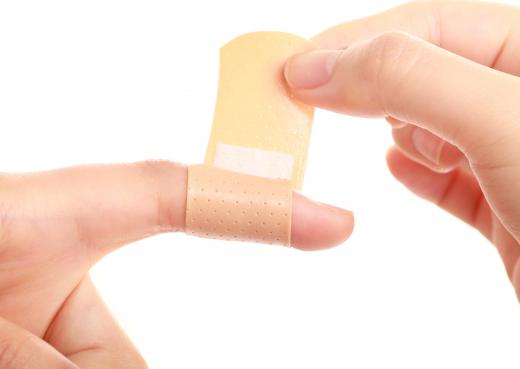A release liner is a layer of material that can coat adhesives or other sensitive substances to protect them until someone actually needs them. These materials are used in applications ranging from medical supplies to electronics. A number of manufacturers produce them for in-house use and also supply companies that need release liners and do not produce them independently. Their components can vary, depending on the intended application.
A classic use for release liners can be seen in adhesive bandages like those used in first aid kits. When someone removes the wrapper to expose the bandage, it is still necessary to remove one or more strips of material to uncover the adhesive. The release liner is covered with an agent that allows it to release readily from the adhesive when pulled, but it will not come loose on its own. It keeps the adhesive sterile and usable until someone is ready for it.

Coated papers, films, and specialized plastics can all be used to make release liners. They can be plain or printed with a variety of designs. The coating used on the adhesive side is specially formulated for a given adhesive. Pressure keeps the adhesive liner in place until someone gently pulls it away, in which case it should lift cleanly away to expose the adhesive. Designers of release liners can develop products for applications like adhesive tape, covering decals and stencils until needed, and backing stickers.
Manufacturers of release liners often produce adhesives. Their knowledge of the chemistry behind their adhesive products allows them to make high performance adhesive liners that go with their adhesive product lineup. In other cases, a customer will need to send in a sample of adhesive and should discuss the need so the company can develop an appropriate liner. It may also be possible to mix additives into the adhesive to facilitate the use of a release liner.
Research and development into such products is an ongoing enterprise at some companies with an interest in developing better adhesives and related products. Some companies may also have concerns about waste, which can be addressed through options like using recycled materials in release liner production, or recommending biodegradeable coatings to customers. Since these materials are designed to be disposable, steps to limit their impact on the environment can focus on using less new materials, or limiting waste at the other end of the product cycle if possible.
Ever since she began contributing to the site several years ago, Mary has embraced the exciting challenge of being a About Mechanics researcher and writer. Mary has a liberal arts degree from Goddard College and spends her free time reading, cooking, and exploring the great outdoors.

